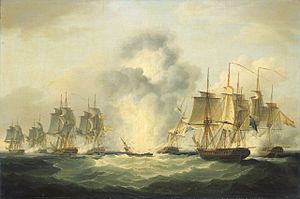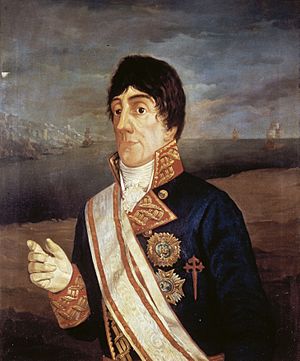José de Bustamante facts for kids
José de Bustamante y Guerra (born April 1, 1759, in Corvera de Toranzo, Cantabria, Spain – died March 10, 1825, in Madrid, Spain) was an important Spanish naval officer, explorer, and politician. He is often simply called Bustamante.
Contents
José de Bustamante y Guerra came from important families in Spain. His father was Joaquín Antonio de Bustamante y Rueda, and his mother was Clara Guerra de la Vega.
In 1770, when he was just 11 years old, Bustamante started his training as a midshipman at the Academy of Guardiamarinas in Cádiz. He quickly moved up the ranks, becoming a second lieutenant of frigate in June 1771.
He served in many naval battles in the Mediterranean Sea, fighting against pirates. During one trip to the Philippines, his ship, the Santa Inés, was captured by a British warship. Luckily, Bustamante was released and returned to Spain.
In 1782, he was wounded in a naval battle near Gibraltar. After this, he helped plan a possible attack on Jamaica, but this plan was stopped when peace was made in 1783. By 1784, he was a frigate captain and a knight of the Order of Santiago.
Around this time, he began planning a big scientific journey with his friend, Alessandro Malaspina.
The Malaspina-Bustamante Expedition
In 1788, Bustamante and Alessandro Malaspina suggested a large scientific expedition to the Spanish government. They wanted it to be like the famous voyages of James Cook. The government approved their idea, and two special ships were built for the journey.
Bustamante commanded the ship named Atrevida, which means "daring" or "bold". Malaspina commanded the Descubierta, meaning "discovered". They chose these names to honor James Cook's ships, the Discovery and Resolution. Both Malaspina and Bustamante were in charge of the expedition together.
The expedition was officially called the "Ultramarine Expedition" and lasted from July 30, 1789, to September 21, 1794. Today, it is usually known as the Malaspina Expedition or the Malaspina-Bustamante Expedition. The team included the best naval officers, along with scientists, artists, and doctors.
From 1789 to 1794, Bustamante and Malaspina sailed across the Atlantic Ocean and the Pacific Ocean. They visited many Spanish colonies and explored less-known areas. Their journey took them to places like:
- Spanish America (including Buenos Aires, Montevideo, Patagonia, Falkland Islands, Chile, Peru, Ecuador, Colombia, Mexico, and California).
- The Pacific Northwest (Alaska), where they searched for a possible passage between the Pacific and Atlantic Oceans.
- Spanish Asia (the Philippines, Marshall and Mariana Islands).
- Other places like Macao (China), New Guinea, Celebes, Moluccas, Tonga Islands, New Zealand, and Australia.
Sometimes, the two ships would separate to do different tasks. For example, Bustamante would stay close to the coast to map it, while Malaspina explored islands further out. Bustamante even sailed very far south, reaching 57 degrees south latitude, which is near the South Pole. This exploration helped Spain, Uruguay, and Argentina claim rights over Antarctica later.
After the expedition returned to Spain in 1794, Bustamante was rewarded. He was promoted to captain in 1791 and then to navy brigadier. He also kept a detailed diary during the expedition, which was published later.
Later Life and Public Service

After returning to Spain, Bustamante continued his work. In 1796, he was appointed as the political and military governor of Paraguay and Commander-General of Río de la Plata (which included Montevideo).
In 1804, while sailing back to Spain with four ships, Bustamante was attacked by a British squadron. This happened during peacetime. He refused to let the British inspect his ships and was captured. He was later released and cleared of any wrongdoing by a Spanish court. This incident led to Spain declaring war on Great Britain in December 1804.
In 1810, Bustamante became the Captain General of Guatemala. He stayed in this important role until 1817. This was a time when many groups in the region wanted independence from Spain. Bustamante worked to keep the area under Spanish rule. He created a group called the "Fernando VII volunteer corps" to help maintain order.
José de Bustamante y Guerra passed away in 1825 when he was 66 years old. In his will, he left a lot of money to support children's schools in Ontaneda, which his brother Francisco had founded.
See also
 In Spanish: José de Bustamante y Guerra para niños
In Spanish: José de Bustamante y Guerra para niños


